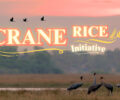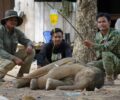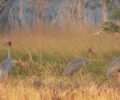Lomphat’s communities driving steps to drought-proof the landscape by keeping water in the forest pools.

Photo: A Giant Ibis forages at a restored trapeang in Lomphat Wildlife Sanctuary. Credit: NatureLife Cambodia
Across South-East Asia, dry dipterocarp forest extent has greatly declined and continues to suffer high rates of habitat loss and degradation. Northern and Eastern Cambodia still retains some of the best and largest stands of this unique type of tropical deciduous forest. Consequently, these forests, such as make up most of Lomphat Wildlife Sanctuary, harbour some of the last populations of endangered and near-endemic species, such as the Giant Ibis Thaumatibis gigantea and the White- shouldered Ibis Pseudibis davisoni, both classed as Critically Endangered by the IUCN.
Both rare birds are heavily dependent on a special types of forest waterhole, called trapeangs in the Khmer language, as at Lomphat and other similar forests they form almost their only foraging habitat during the prolonged and pronounced dry season from January to April. During peak dry season, these forests become almost completely parched, with all but the largest rivers drying out entirely, but the types of fish, eels, frogs and macro-invertebrates that the ibis eat are still relatively abundant in and around the trapeangs.
This scarcity of water in dry forests is significant limiting factor for these ibis, but also for other large- bodied water birds, as well as other animals; wild ungulates being prime example. As the dry season progresses, significant numbers of trapeangs dry out, and while this tendency to dry out is a natural occurrence, observations by field monitoring teams, and reports by communities in the region seem
to suggest this tendency may be increasing. Especially during droughts such as those encountered in recent El-Nino years, a worryingly large proportion of trapeangs become completely dried out, sometimes early in the dry season.

Photo: By March, this trapeang has already dried out.
As climate change follows its projected path, the water-retaining ability of trapeangs should be expected to be negatively impacted. Trapeang dependent wildlife will also experience ever-increasing additional pressures and disturbances from anthropogenic activities and deforestation also contributes to disrupting water tables.
Trapeangs are not just essential for maintaining biodiversity, they also provide much needed natural resources for local communities and Indigenous People in the Lomphat landscape. When used sustainably, trapeangs provide a much-needed source of fish and other edible vertebrates, herbaceous plants, as well as enabling the traditional livestock husbandry methods for owners of cows and buffaloes. During the hottest and dryest months, collecting fodder to feed herds kept at the village would be near impossible, so cows and buffaloes are allowed to wander unsupervised in the forests around villages.
Communities in Lomphat are also concerned by this apparent continuing trend. Furthermore, for the least developed communities trapeangs provide a much-needed source of water for household use during these times. Mr. Hoem Cheavlei, a 66-year-old resident of Nang Khi Loek Village in the southern part of the wildlife sanctuary told us there is a need to do something to address the issue.
‘It’s a bad situation for everyone if the trapeangs are dry. We need to take some action to prevent this, together with wildlife conservation organisations.
To mitigate this existing water scarcity, and to prepare for a possible future, harsher climate, the most feasible option available is to modify the depth of the trapeangs. By selectively deepening the profile of the trapeang, they are able to hold water longer. Given the critically important nature of trapeang habitats in dry forest landscapes, plus the proven feasibility and effectiveness of previous trapeang
restoration projects, trapeang restoration represents a valuable opportunity for protected area managers.
At Lomphat, NatureLife Cambodia has been pursuing this strategy since 2019, with 17 trapeangs deepened between 2019 and 2022. In 2023, 6 more were deepened. NatureLife Cambodia (NLC) is a Cambodian conservation organisation and the official partner of BirdLife International in Cambodia. With a mission to conserve biodiversity by managing natural resources sustainably for the benefits of local communities and biodiversity, in 2019 the MoE and NatureLife agreed to develop the LWS REDD+ Project, aims to generate carbon credits by reducing the deforestation and forest degradation activities that lead to greenhouse gas emissions. This project has since been implemented through the support of USAID Morodok Baitang.
Before deciding to go ahead, an important step is to seek the consent and collaboration with all local communities near to the restoration. NatureLife Cambodia therefore organised meetings in the six communities to find out what they think about the idea. 186 people attended those meetings, and they were unequivocal about the need to go ahead and do it.

Photo: NatureLife Cambodia hold a village workshop to discuss trapeang restoration.
Mr. Thorng Savet, a member of the Local Conservation Group told us that ‘Trapaeng restoration gives a lot of advantages to wildlife and livestock, but also for people while they go to collect the non-timber products, for example; drinking water, cooking, bathing. Wild animals can also drink and forage better at restored trapeangs’.
Another local person, Mr. Nhoeng Seng agreed ‘Based on my idea, the first benefit is for wildlife, the second benefit is for livestock, and the third is for people. For wildlife, restored trapeangs give food; when they hold water, so they have food. It’s important for livestock to be able to have water to drink, and so they often sleep there too. For people, benefits can be fishing there sometimes, and we can pick vegetables whenever they pass by the trapaengs’.
Trapeang restoration projects should strive to achieve two overarching objectives. Firstly, they must improve the ecological value of the forest wetland habitats to native wildlife, and secondly, they should
enhance the utility value of trapeangs to local communities for sustainable practices. To ensure they meet these criteria, restoration sites are identified and screened, then communities are asked for their feedback and consent to participate in the work. While mechanical excavation is faster and capable of excavating faster, the method employed so far at Lomphat has been to manually deepen trapeangs by parties of local community members. This method both delivers benefits to communities via the paid employment, as well as being more sensitive to the surrounding ecosystem. There are some risks involved, notably the exclusion of wildlife from the trapeang site while work is being carried out, but this is taken into consideration during planning. Trapeangs are deepened in one continuous period of less than a week, and are not conducted simultaneously at many locations in one localised area (also are necessarily deepened when dry, and therefore are being much less used by wildlife).

Photo: Communities in the early and later stages of deepening the waterholes.
The following season after restoration NatureLife Cambodia’s LWS Field Monitoring Team (FMT) visit the trapeangs and collect data directly, especially throughout the dry season to determine if the restoration has successfully increased the ability to hold water. Other biodiversity and community-use monitoring data is collected seasonally and year-round though ground surveys, camera-trapping, and also by PA and community patrols.

Photo: White-shouldered Ibis making use of the soft mud for catching prey by a restored waterhole.
Positive results, especially the increased water retaining capacity of the trapeangs have been recorded. Previously restored trapeangs have been seen to retain water levels right through the end of March and through April, whereas unrestored trapeangs tend to rapidly drop in water level during this period. Additionally, while all trapeangs started with a similar amount of vegetation in December, restored trapeangs have been recorded to retain similar amounts of vegetation cover all the way till the end of April, providing important fodder for grazers and micro-habitats critical to the food chain. Comparatively, the amount of vegetation cover in unrestored trapeangs declines very fast from the start of March onwards.
These results have also been noticed by local communities. Norng Khilik mentioned he has seen the positive results of previous trapeang restorations near his home. ‘Restored trapaengs store more water and can keep the water longer than non-restored trapaeng’ he says, ‘this means instead of drying out, our domestic animals can drink water at the restored trapaengs’.

Photo: Available drinking water is essential for free-ranging livestock.
The success of trapeang restoration efforts at Lomphat Wildlife Sanctuary highlights the crucial role these waterholes play in supporting both biodiversity and local communities, and underscore the importance of continued investment in sustaining these types of projects. As climate change and anthropogenic pressures threaten these fragile ecosystems, proactive management and community involvement become ever more essential. The LWS REDD+ Project – as well as reducing the emissions and preventing further climate change – is the best mechanism to achieve this. It is paramount to not only protect endangered species like the Giant Ibis and White-shouldered Ibis but to also bolster the resilience and well-being of the human populations that depend on these vital resources. Only by preserving these unique habitats, can steps be taken towards safeguarding the natural heritage of South-East Asia for future generations.
Tagged:



